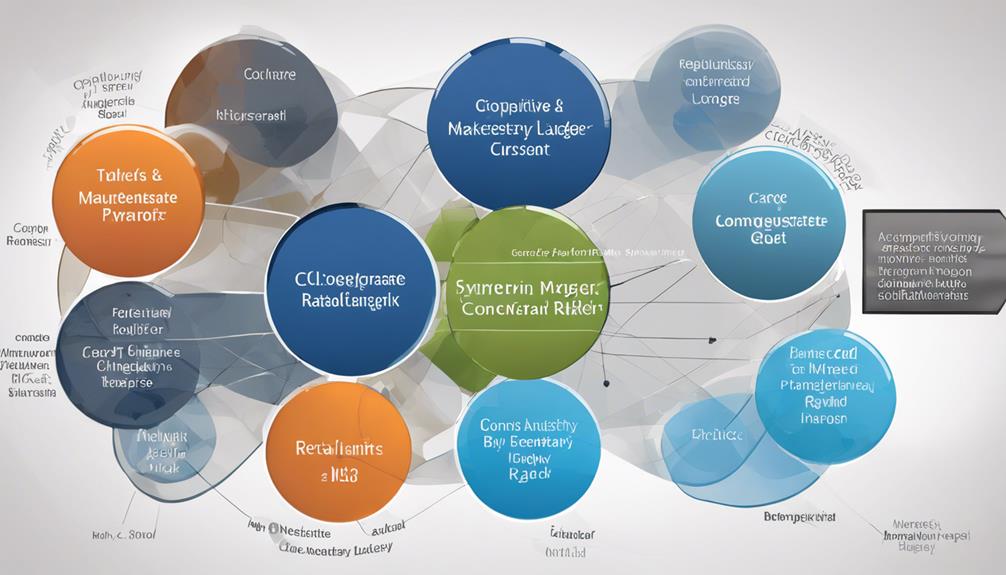Regulatory and Legal Aspects of Conglomerate Mergers

As conglomerate mergers increase, understanding the various types of mergers and acquisitions becomes crucial. Antitrust authorities closely examine these transactions to prevent monopolistic behavior and maintain fair competition in the market.
Compliance with antitrust laws is essential, as regulators assess aspects like market control and integration to ensure that mergers do not disrupt the competitive landscape. Collaboration with authorities and adherence to best practices enable organizations to achieve growth while upholding ethical standards.
Exploring the latest trends and case studies in this area can provide valuable insights into the oversight of conglomerate mergers.
Key Takeaways
Regulatory bodies closely examine conglomerate mergers to prevent anti-competitive practices and uphold fair market competition as per antitrust laws. Merger notification to authorities is compulsory, and non-compliance can lead to significant repercussions such as fines or penalties being imposed.
Authorities evaluate various factors like market dominance, pricing power, and potential impact on consumers to ensure that mergers do not disrupt the balance of the market. It is essential for conglomerate mergers to operate within the bounds of regulatory frameworks and ethical guidelines, addressing any conflicts of interest and maintaining transparency throughout the process.
Recent trends in conglomerate merger regulations emphasize the assessment of competitive implications, the alignment of regulatory practices across different jurisdictions, and the prevention of any negative consequences on the market. It is crucial for companies engaging in conglomerate mergers to stay abreast of these evolving regulatory landscapes to navigate the process effectively and ethically.
Definition and Characteristics of Conglomerate Mergers
Conglomerate mergers bring together companies from different industries, creating a diversified entity with a broad range of business activities. These mergers are characterized by firms joining forces across unrelated sectors, maintaining their separate operations post-merger, and seeking to expand their market reach or product offerings. By combining their strengths and resources, companies can capitalize on synergies, reduce risks, and seize new growth opportunities.
Diversifying into new markets, reaching untapped customer segments, and acquiring innovative technologies are key benefits of conglomerate mergers. This strategic blending of capabilities enables organizations to enhance their agility, foster innovation, and adapt to changing market conditions. Understanding the distinct features and definition of conglomerate mergers is crucial for navigating the regulatory and legal complexities associated with these transactions.
In essence, conglomerate mergers serve as a strategic tool for companies to broaden their business horizons, strengthen their competitive position, and drive sustainable growth. By uniting diverse businesses under one umbrella, organizations can harness the power of synergy and expand their market presence, paving the way for long-term success in the dynamic business landscape.
Antitrust and Competition Regulations

Antitrust regulations are crucial in examining conglomerate mergers to prevent them from impeding market competition or enabling monopolistic behavior. It's imperative to carefully scrutinize these intricate transactions to avoid the consolidation of market power.
Antitrust authorities rigorously analyze conglomerate mergers to prevent any potential abuse of market dominance and enforce regulations that prioritize sustaining a competitive market environment.
Adhering to antitrust and competition laws is vital for conglomerate mergers to steer clear of legal complications and promote innovation. Thorough evaluations of these mergers help ensure that they don't disrupt the market equilibrium, thus preserving the dynamic nature of the economy driven by entrepreneurial endeavors.
As specialists in this field, we're committed to maintaining a balance that encourages growth while safeguarding the market's integrity.
Compliance With Antitrust Laws

When it comes to antitrust compliance, it's crucial to understand the various types of mergers and acquisitions that can impact competition in the market. One common type is a conglomerate merger, where companies operating in different industries or sectors come together.
In conglomerate mergers, regulatory bodies assess the potential market dominance of the combined entity. This evaluation is important to prevent the creation of monopolies or oligopolies that could harm competition.
Horizontal integration, where companies in the same industry merge, can lead to increased market power and potential antitrust issues. On the other hand, vertical integration, involving companies in different stages of the supply chain, may raise different concerns related to access and control of critical inputs.
Understanding the distinctions between horizontal and vertical integration in conglomerate mergers is essential for companies to navigate antitrust regulations effectively. By adhering to these laws, businesses can contribute to maintaining a level playing field and promoting fair competition in the marketplace.
Merger Notification Requirements
Merger notification requirements are crucial for companies to adhere to antitrust laws and regulations. These requirements mandate that companies inform regulatory authorities before finalizing mergers, ensuring compliance with fair competition standards. Failure to fulfill these obligations can lead to severe consequences such as penalties, fines, or even the undoing of the merger. Antitrust laws are designed to prevent any anti-competitive practices and maintain a level playing field in the market.
The specific thresholds for notification vary across different jurisdictions. Some countries may necessitate notification based on factors like the transaction's size or the parties involved. Properly notifying regulatory bodies allows for a comprehensive evaluation of the merger's potential impact on competition and consumers.
In the United States, companies must notify authorities if the transaction value exceeds $94 million. Failure to do so can result in penalties, fines, or even the reversal of the merger.
The European Union requires notification if the parties' combined worldwide turnover surpasses €5 billion, with potential fines reaching up to 10% of the companies' revenue.
Similarly, in Canada, notification is necessary if the assets involved in the merger exceed $93 million, with potential administrative monetary penalties for non-compliance.
Market Dominance Considerations
Regulators are primarily concerned about conglomerate mergers potentially leading to market dominance. This dominance could allow the merged entity to engage in anti-competitive practices that harm consumers. Adhering to antitrust laws is crucial in these cases. Regulators need to ensure that the merger doesn't result in excessive control over the market.
Antitrust regulations aim to prevent monopolistic behavior and maintain a competitive marketplace. When assessing conglomerate mergers, authorities carefully consider factors such as market share, pricing influence, and the impact on competition and consumers. If they find that the merger could create too much market power, they may mandate divestitures or impose specific conditions to address these issues.
A competitive business environment is vital for fostering innovation and safeguarding consumer choice. We're dedicated to collaborating with regulators to address concerns about market dominance and uphold antitrust principles during the merger review process.
Horizontal Vs. Vertical Integration
Distinguishing between horizontal and vertical integration is crucial when assessing conglomerate mergers for compliance with antitrust laws.
Horizontal integration involves the merging of companies within the same industry, which can raise concerns about market concentration and potential anticompetitive practices.
On the other hand, vertical integration combines firms at different stages of the supply chain, impacting competition and potentially leading to market foreclosure.
To evaluate the regulatory implications of conglomerate mergers, it's essential to understand these differences:
- Horizontal integration may warrant closer scrutiny to ensure it doesn't create a dominant market position that hampers competition.
- Vertical integration should be examined for its ability to exclude competitors from the market and restrict consumer choices.
- Adherence to antitrust regulations is crucial, as conglomerate mergers must comply with laws aimed at preserving market competition and safeguarding consumer welfare.
Market Analysis in Conglomerate Mergers

When we delve into conglomerate mergers, our primary focus is on analyzing the market dynamics to understand how they could impact competition, pricing, and the overall industry landscape.
Our meticulous market analysis delves into the potential effects of the merger on market power, consumer choices, and innovation within the industry. We pay close attention to factors like market concentration, barriers to entry, and the possibility of collusion, as these are crucial aspects in assessing the competitive environment after the merger.
A comprehensive market analysis is essential for regulators like us to assess both the potential negative impacts on competition and the possible economic efficiencies that conglomerate mergers might bring. This methodical approach ensures that the merger doesn't hinder competition or create market distortions that could harm consumers in the long run.
Navigating the Complexities of Conglomerate Mergers

Understanding the complexities of conglomerate mergers requires a comprehensive approach that carefully examines the legal and regulatory landscape. In this field, experts emphasize the need to analyze the impact on market dynamics. It's crucial to assess how a conglomerate merger might change the competitive landscape, affecting aspects like innovation, pricing, and the overall balance of power within the industry.
Another key aspect to consider is ensuring compliance with antitrust laws. Adhering to these regulations is essential for evaluating the potential harm to competition and consumer welfare that can stem from conglomerate mergers. By closely examining the strategic implications of these mergers, experts can better understand the long-term effects. This includes assessing the creation of new competitive advantages and the consolidation of market share, which play a significant role in determining the overall impact on the industry.
Ensuring Fair Competition and Preventing Monopolies

Why do regulatory bodies closely examine conglomerate mergers to ensure fair competition and prevent monopolies from forming? The reason is simple: keeping the market competitive is crucial. That's why a thorough evaluation is done to understand the potential impact of these big corporate mergers.
By enforcing antitrust laws, the goal is to stop any actions that could harm competition that may arise from these mergers, protecting consumer choice and fair prices.
When assessing conglomerate mergers, regulators look at various factors such as market share, industry concentration, barriers to entry, and the impact on innovation. They weigh the potential benefits like economies of scale, diversification, synergies, and operational efficiency against the risks of reduced competition, price manipulation, abuse of market power, and limited consumer choice.
The guidelines set by regulators aim to strike a balance, allowing the benefits of conglomerate mergers while ensuring fair competition. It's all about creating an environment where innovation can flourish, and consumers can enjoy the benefits of a market driven by healthy competition.
Safeguarding Consumer Interests in Conglomerate Mergers

Protecting consumer interests is crucial in scrutinizing conglomerate mergers since these large corporate unions can significantly influence market dynamics and competition. Regulatory oversight and antitrust regulations play a vital role in ensuring consumer welfare in such scenarios.
Consumer protection agencies meticulously assess potential mergers, taking into account factors like:
- The threat of price hikes for consumers
- The potential decrease in consumer options
- The risk of hindering innovation
These considerations are essential to prevent any negative consequences that conglomerate mergers may have on consumers and the overall market.
Regulatory Frameworks for Conglomerate Mergers

Regulatory frameworks worldwide oversee conglomerate mergers, giving authorities the power to scrutinize these corporate consolidations. Antitrust laws are crucial in this process, ensuring mergers don't result in anti-competitive practices or monopolistic behavior that could harm consumers.
Authorities globally have established specific guidelines and regulations to evaluate the potential impact of conglomerate mergers on market dynamics, pricing, and competition levels. This thorough evaluation considers factors like market shares, barriers to entry, and the risk of higher prices or limited product choices for consumers.
Companies involved in conglomerate mergers must comply with these regulatory frameworks to avoid legal issues and hefty penalties. Adhering to the rules is essential, highlighting the significance of understanding and following the applicable laws and regulations.
These frameworks protect the competitive environment, maintaining a fair marketplace that encourages innovation and safeguards consumer interests.
Ethical Considerations in Conglomerate Mergers

When considering ethical aspects in conglomerate mergers, it's crucial to examine potential conflicts of interest and ensure transparency in communication and decision-making processes. As responsible stewards, it's essential to uphold legal and regulatory compliance, including antitrust laws, to ensure fair treatment for all stakeholders impacted by these significant transactions.
Conglomerate mergers involve companies from different industries coming together, often with diverse products and services. This type of merger can lead to synergies and diversification, but it also raises concerns about competition and market dominance.
Ensuring that these mergers don't stifle competition or harm consumers is vital. By following antitrust laws and regulations, companies can navigate these mergers ethically and responsibly. Transparency in the merger process is key to building trust with stakeholders and demonstrating a commitment to fair business practices.
Potential Conflicts of Interest
Potential conflicts of interest are a major concern in conglomerate mergers, as executives may prioritize their personal financial interests over the well-being of shareholders. It's crucial to ensure transparency in the decision-making process and disclose any potential conflicts to all stakeholders involved.
Regulators keep a close eye on conflicts of interest to ensure fair treatment of all parties. To address these issues, companies can:
- Implement strong disclosure requirements to make the factors influencing the merger decisions transparent.
- Establish independent committees or advisors to provide impartial guidance and oversight.
- Promote ethical conduct and the protection of shareholder value above personal gain.
Stakeholder Transparency Obligations
Ensuring transparency with stakeholders is crucial during a conglomerate merger. Transparency builds trust, reduces uncertainty, and helps everyone involved understand the impact of the merger.
Shareholders must receive all relevant financial and strategic information. Employees need clear communication about changes in roles, responsibilities, and benefits. Customers should be informed about any adjustments to products, services, or pricing. Regulators must be provided with all necessary disclosures and reports to comply with legal requirements.
Ethical considerations are vital in maintaining fairness and accountability for all stakeholders. Companies should prioritize honesty, integrity, and a genuine dedication to protecting the interests of employees, customers, and the community.
Mitigating Risks in Conglomerate Mergers

Thoroughly examining the financial, legal, and operational aspects through due diligence is crucial in mitigating risks in conglomerate mergers. By ensuring compliance with regulations, such as antitrust laws and competition rules, we can navigate the legal complexities effectively.
Additionally, clear communication and aligning goals between merging entities are key to overcoming integration challenges and cultural differences.
To further reduce potential risks, it's advisable to implement strong risk management strategies, including:
- Developing contingency plans to address unexpected issues
- Conducting post-merger monitoring to identify and resolve emerging concerns
- Seeking guidance from legal experts and advisors specializing in mergers and acquisitions.
Case Studies of Conglomerate Mergers

Let's delve into a few notable conglomerate mergers that have grabbed headlines. These case studies will provide us with insights into the regulatory hurdles and the impact on market competition.
Notable Conglomerate Mergers
Successful conglomerate mergers can be seen in various industries. General Electric's acquisition of NBC in 1986, Berkshire Hathaway's diverse holdings, and Johnson & Johnson's expansion into medical devices are prime examples. These mergers demonstrate the strategic growth and market impact achievable through conglomerate structures.
Berkshire Hathaway's conglomerate model has enabled it to diversify its portfolio and seize opportunities across different sectors, such as insurance and manufacturing. Similarly, Tata Group's conglomerate structure showcases successful mergers in automotive, steel, and telecommunications.
Volkswagen Group's ownership of multiple automotive brands like Audi, Porsche, and Lamborghini highlights the market presence and synergies resulting from conglomerate mergers. These instances underscore the potential benefits of conglomerate structures, fostering innovation, boosting competitiveness, and delivering value to shareholders.
Regulatory Challenges Faced
Conglomerate mergers often undergo regulatory scrutiny as antitrust authorities assess their potential impact on competition. Understanding the complexities of these mergers is crucial for ensuring fair market practices and protecting consumers. Evaluating market power involves examining the merged entity's ability to influence prices and output levels. Efficiency gains must be carefully weighed against any potential negative effects on competition to determine the overall impact of the merger.
Regulators play a key role in ensuring that conglomerate mergers don't lead to market dominance or the exploitation of market power. By enforcing competition laws and merger control regulations, authorities aim to maintain a level playing field for businesses and safeguard consumer welfare. The case of the GE-NBC merger serves as a notable example of the importance of thorough regulatory review in conglomerate mergers to promote fair competition and market efficiency.
It is essential for regulatory bodies to closely scrutinize conglomerate mergers to uphold principles of fair competition and prevent any potential harm to market dynamics. Compliance with antitrust guidelines and competition laws is paramount in ensuring that conglomerate mergers don't stifle competition or harm consumer interests. By fostering competitive markets through effective oversight and regulation, regulators can create an environment where businesses can thrive while also benefiting consumers.
Impact on Market Competition
Studying conglomerate mergers can help us understand how they impact market competition. For example, when Google acquired YouTube, it expanded its market reach and gained a competitive advantage. Similarly, Disney's acquisitions of Pixar and Marvel show how diversification through conglomerate mergers can be strategically beneficial.
There are three main ways conglomerate mergers can influence market competition.
First, they can change market concentration by merging businesses, leading to potential economies of scale.
Second, conglomerate mergers can help companies broaden their product offerings and customer base, giving them a competitive edge.
Lastly, these mergers can provide access to new technologies, talent, and resources that promote innovation.
Regulatory bodies scrutinize conglomerate mergers to prevent any anti-competitive behavior and safeguard consumer interests. Understanding how these mergers impact market dynamics is crucial for assessing their broader effects on competition, innovation, and the overall marketplace.
Best Practices for Conglomerate Merger Compliance

To ensure successful compliance in conglomerate mergers, it's crucial to thoroughly analyze the market landscape and conduct comprehensive regulatory due diligence. Implementing strong governance structures and monitoring mechanisms is key to staying compliant throughout the merger process.
Understanding the competitive dynamics and potential antitrust implications allows us to proactively address regulatory concerns and reduce risks. By examining market share, customer segmentation, and supplier networks, we can anticipate areas that may draw regulatory scrutiny. A careful review of relevant competition laws and notification requirements helps us navigate the intricate regulatory frameworks.
Building robust governance structures with clear decision-making processes and accountabilities ensures smooth coordination between merging companies. Regular monitoring and reporting of compliance metrics enable us to quickly identify and address any issues that may arise. Transparency and thorough documentation show our dedication to regulatory compliance to oversight authorities.
Emerging Trends in Conglomerate Merger Regulations

In the realm of merger regulations, there's a noticeable shift towards evaluating the competitive impacts of conglomerate mergers. One crucial area of focus is analyzing the risks of foreclosure through bundling or tying in related markets, which is a key aspect to consider when assessing these diversified conglomerate mergers.
Moreover, there's a growing emphasis on the discrepancies between U.S. and E.U. practices in this field, highlighting the significance of regulatory harmonization. Present regulatory guidelines stress on averting adverse effects through ex-post control and the prohibition of abusive dominant positions. The prohibition of abusive practices can act as a deterrent, as seen in the regulatory approaches adopted in the U.S.
Concerns regarding a merger's influence on market share in both primary and adjacent markets are pivotal in the assessment of conglomerate transactions.
As the regulatory landscape progresses, it's essential for companies navigating the complexities of conglomerate merger compliance to stay informed about these emerging trends.
The Future of Conglomerate Merger Oversight

Looking forward, the future of overseeing conglomerate mergers will likely involve a more proactive and thorough evaluation of how these transactions impact market competition and consumer welfare. Regulatory bodies are expected to pay closer attention to the potential for anti-competitive behavior and market dominance that may arise from these mergers. We anticipate an increase in scrutiny, with authorities aiming to establish stricter guidelines and enforcement actions to prevent any negative consequences.
The evolving landscape of technology and global market trends will undoubtedly influence how conglomerate mergers are monitored in the future. Antitrust policies and regulations may undergo significant changes to better adapt to the dynamic business environment. The objective will be to find a middle ground between encouraging innovation and safeguarding the interests of consumers and the overall market.
In the end, effective oversight of conglomerate mergers will necessitate a delicate balance between fostering economic growth and upholding the principles of fair competition. Regulatory agencies will need to stay alert and adaptable in their approach to ensure positive outcomes for all parties involved.
Frequently Asked Questions
What Are the Concerns of Conglomerate Merger?
We worry about conglomerate mergers because they could result in monopolistic behavior, risks associated with unrelated diversification, and challenges in regulatory oversight. While we acknowledge the potential for innovation that these mergers may bring, our focus is on striking a balance between fostering competition and facilitating progress.
When conglomerate mergers occur, there is a possibility that companies may abuse their dominant position in the market, leading to limited choices for consumers and potentially higher prices. This concern is supported by historical examples where conglomerates have faced antitrust lawsuits due to their monopolistic practices.
Moreover, the risks of unrelated diversification in conglomerate mergers cannot be ignored. When companies diversify into unrelated industries, they may spread themselves too thin, leading to decreased efficiency and focus. This could ultimately harm the overall performance of the merged entity and negatively impact shareholders.
In addition to these risks, regulatory oversight challenges often arise in conglomerate mergers due to the complexity of managing diverse business operations under one umbrella. Ensuring compliance with various regulations across different industries can be a daunting task, raising concerns about transparency and accountability.
While conglomerate mergers have the potential to drive innovation and create synergies between different industries, it is crucial to carefully evaluate the potential risks and challenges associated with such mergers. By staying vigilant and promoting healthy competition, we can strive to harness the benefits of conglomerate mergers while mitigating their negative consequences.
What Is a Legal Conglomerate?
Diving into the realm of diversification, a legal conglomerate is a hub for merging various businesses horizontally, into products, and unrelated ventures all in one place. By bringing these different entities together, we can take advantage of the benefits of scale and uncover new avenues for growth and innovation.
Conglomerate mergers involve combining companies that operate in different industries or sectors, expanding the reach and capabilities of the overall organization. This type of merger can lead to increased market power, diversification of risk, and the ability to leverage the strengths of each individual business for collective success.
One famous example of a conglomerate merger is the acquisition of ABC by Disney in 1995. This move allowed Disney to expand its media empire by incorporating a major television network into its portfolio, leading to increased revenue streams and a stronger foothold in the entertainment industry.
What Are the Characteristics of a Conglomerate Merger?
Conglomerate mergers are characterized by the combination of companies operating in different industries, aiming to achieve vertical synergies and horizontal diversification. This strategic move allows companies to broaden their market reach and reduce risk by diversifying into unrelated sectors. By venturing into new and diverse markets, conglomerate mergers create opportunities for growth and enhance resilience.
Are Mergers and Acquisitions Regulated by Laws?
Mergers and acquisitions face strict regulation, with antitrust enforcement agencies reviewing more than 1,800 transactions each year to uphold market competition. Compliance with regulatory oversight is crucial to driving innovation while protecting consumer interests.
Conglomerate mergers, a type of merger where companies from unrelated industries come together, are a unique category in the realm of mergers and acquisitions. These mergers often involve companies with diverse product lines or services, aiming to diversify their business interests and create synergies to improve overall performance.
In the past, conglomerate mergers have been both praised for their potential to drive growth and criticized for their complexity and potential negative impact on market competition. Understanding the dynamics of these mergers is important for companies looking to expand their reach and explore new opportunities in the market.
Conclusion
Understanding the regulatory and legal aspects of conglomerate mergers can be quite intricate. Antitrust laws play a crucial role in shaping the landscape of mergers and acquisitions, ensuring fair competition and market efficiency.
Market analysis is essential in determining the potential impacts of conglomerate mergers on competition and consumer welfare. Keeping abreast of emerging trends in merger oversight is key to navigating this complex terrain successfully.
By implementing best practices and staying informed about the future of merger regulation, companies can execute conglomerate mergers that not only drive business growth but also contribute to a vibrant and competitive marketplace. It's essential for organizations to prioritize compliance with antitrust laws and regulations to mitigate risks and ensure the success of their mergers.
Conglomerate mergers have the potential to reshape industries and create new opportunities for growth and innovation. By approaching these mergers with a clear understanding of the regulatory environment and a commitment to compliance, companies can position themselves for long-term success in an ever-evolving business landscape.





